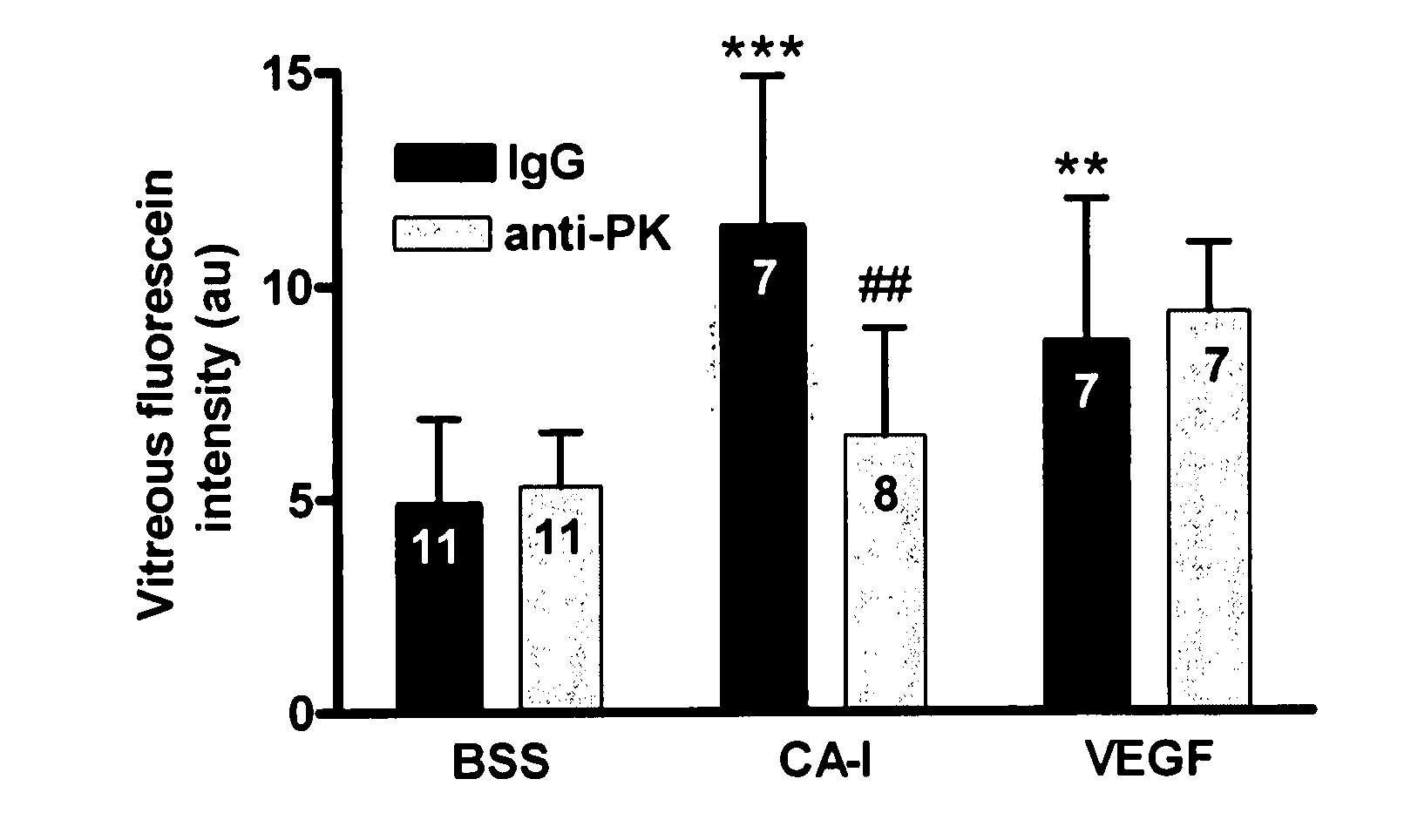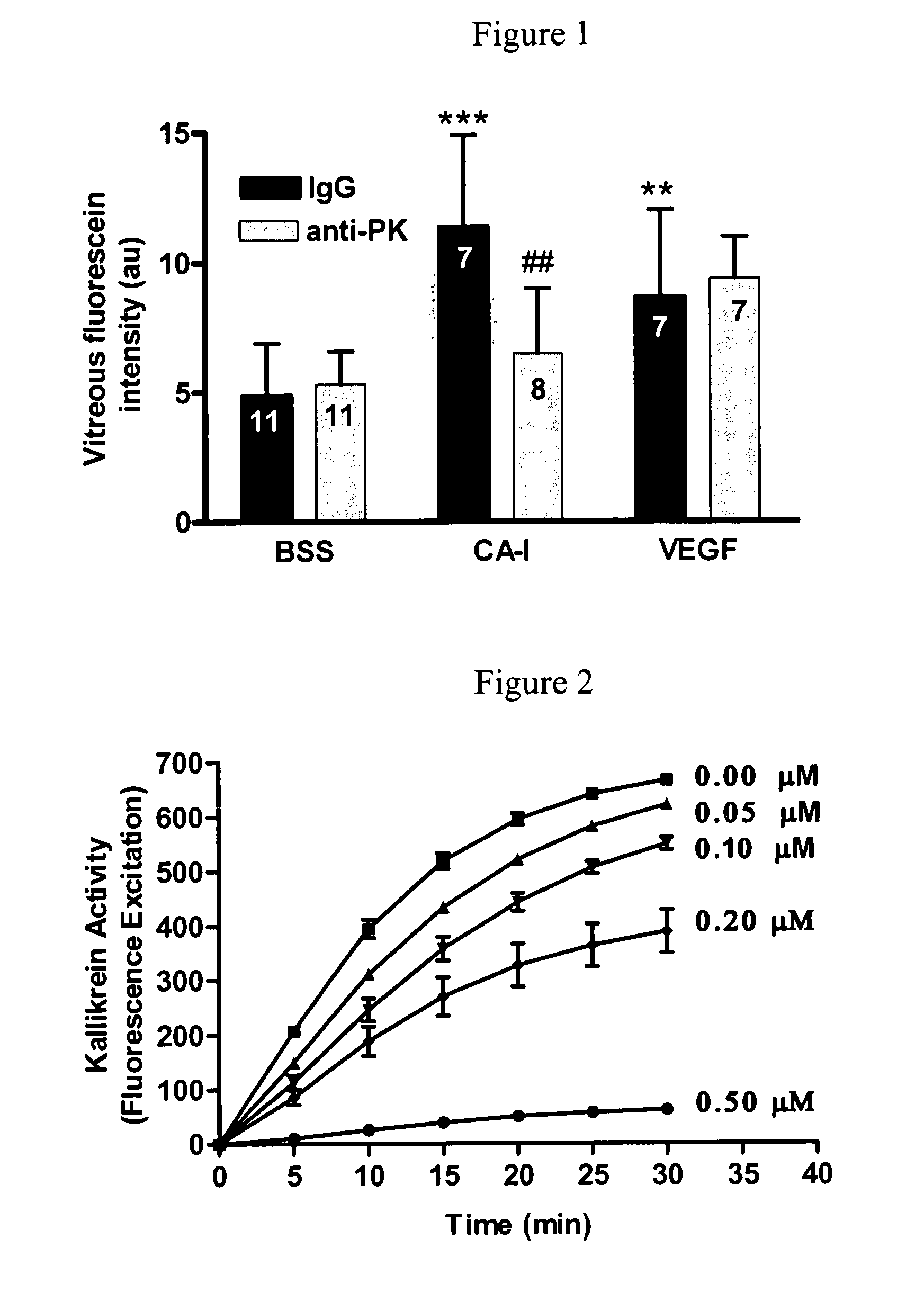Methods of diagnosing, treating, and preventing increased vascular permeability
a technology of which is applied in the field of treating and preventing increased vascular permeability and edema, can solve the problems of increased permeability of brain capillary endothelial cells, cerebral herniation, and contribute to neuronal cell death, and achieve the effect of reducing the risk of future hemorrhag
- Summary
- Abstract
- Description
- Claims
- Application Information
AI Technical Summary
Benefits of technology
Problems solved by technology
Method used
Image
Examples
example 1
CA-1 Induced Increases in Retinal Vascular Permeability are Mediated by the Kallikrein-Kinin Pathway
[0102]The role of carbonic anhydrase 1 (CA1) and C1-inhibitor (C1-INH) in retinal vascular permeability (RVP) has been previously described, see International Patent Application No. PCT / US2006 / 0053, filed Feb. 16, 2006 and published as WO 2006 / 091459; the entire contents of that application are incorporated by reference herein. As shown therein, high levels of carbonic anhydrase-1 (CA-1) were identified in vitreous from patients with advanced diabetic retinopathy. Intravitreal injection of CA-1 in rats increased retinal vascular permeability. This response was comparable in magnitude, additive to vascular endothelial growth factor (VEGF)-induced permeability, and blocked by C1 inhibitor (C1-INH) and antagonists of the kallikrein-bradykinin receptor pathway. Further, carbonic anhydrase inhibition by acetazolamide blocked the increased retinal permeability in rats induced by transplant ...
example 2
Alkaline pH Mimics the Effects of CA-1
[0110]CA plays a central role in the regulation of extracellular pH and the retina contains robust mechanisms for ion transport. The effect of CA-I on vitreous pH was measured using a microminiature electrode via an opening through the sclera or a pH sensitive fluorescent probe, 2′,7′-bis-(2-carboxyethyl)-5-(and-6)-carboxyfluorescein (BCECF) conjugated to 70 kDa dextran. Using the electrode, we found that the pH of vitreous 5 min after injection of CA-1 was 7.8±0.21 compared with the pH of 7.4±0.15 following injection of BSS vehicle (P<0.002) (FIG. 4).
[0111]This electrode was also used to directly measure the pH of vitreous following an intravitreal injection with BCECF-dextran dye in either BSS at pH 7.4 or HEPES buffer at pH 8.0 following measurement of vitreous fluorescence. Using a pH sensitive dye and reference pH, the vitreous pH was calculated to be 7.96±0.38 following intravitreal injection of CA-I.
[0112]To determine the effect of an alk...
example 3
The Contact System is Present and Activated in the Vitreous of Patients with PDR
[0113]Since the data described above showed that anti-PK antibody blocked both CA-I- and BSS pH 8.0-induced RVP (FIGS. 1 and 5), the presence of components of the kallikrein system in human vitreous was examined, and the effect of pH on the kallikrein pathway was investigated. Activation of the kallikrein system via the contact system involves both (i) kallikrein-mediated cleavage of FXII to FXIIa and (ii) FXIIa-mediated cleavage of PK to kallikrein. As shown in FIG. 6, vitreous from patients with PDR contains PK, kallikrein, FXII, FXIIa, and kininogen heavy chain.
[0114]High molecular weight kininogen (HK) is also present in the vitreous. Comparison of vitreous PK and FXII with 20 ng of purified PK or FXII controls indicates that PDR vitreous contains low μg / mL levels of these proteins. The appearance of both kallikrein and FXIIa in these samples suggests that the contact system is present and activated ...
PUM
| Property | Measurement | Unit |
|---|---|---|
| Permeability | aaaaa | aaaaa |
Abstract
Description
Claims
Application Information
 Login to View More
Login to View More - R&D
- Intellectual Property
- Life Sciences
- Materials
- Tech Scout
- Unparalleled Data Quality
- Higher Quality Content
- 60% Fewer Hallucinations
Browse by: Latest US Patents, China's latest patents, Technical Efficacy Thesaurus, Application Domain, Technology Topic, Popular Technical Reports.
© 2025 PatSnap. All rights reserved.Legal|Privacy policy|Modern Slavery Act Transparency Statement|Sitemap|About US| Contact US: help@patsnap.com



